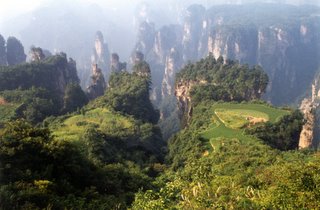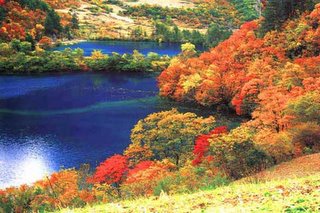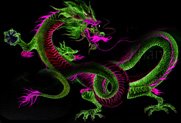Shopping in Xian, China Mainland
Xian is rich in local produce with a lot of world-renowned products. Shopping in Xian now is becoming more convenient along with many shopping centers, supermarkets, shopping streets and also special shopping streets springing up in the city. Shopping is one of the interesting way to get the true chinese experience in Xian.
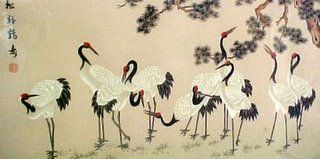 Qin Embroidery was originally a long established art form of Shaanxi Province; it was developed by local master embroiders on the basis of traditional Chinese embroideries. Qin embroidery is very well known for its elegant and neat needlework, finely stitched patterns positioned in proper perspective, a riot of colors and a good effect of tone and depth of the fine work.
Qin Embroidery was originally a long established art form of Shaanxi Province; it was developed by local master embroiders on the basis of traditional Chinese embroideries. Qin embroidery is very well known for its elegant and neat needlework, finely stitched patterns positioned in proper perspective, a riot of colors and a good effect of tone and depth of the fine work.
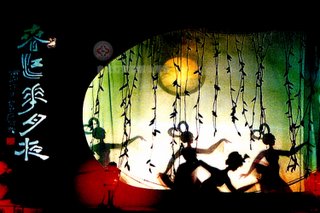 Leather sihoulettes are made of cattle hide, sheepskin and donkey hide after they are oppressed, polished, carved and painted. It was originated since the Han Dynasty 206 B.C. - 220 A.D., Guangzhong leather Silhouettes have inherited the traditions of Han stone frescoes and developed the advantages of paintings of the Song Dynasty 960 - 1279. Local artisans display the figures' facial features, status, clothes and personalities through precise and meticulous carving. Guangzhong leather - Silhouette show is characterized by life-like figures, and a strong local, ethic and artistic flavor, hence it has been well received by domestic and foreign tourists. The classical works of Guangzhong leather-Silhouette show includes "Princess Wencheng Enters Tibet and Imperial Concubine Yang".
Leather sihoulettes are made of cattle hide, sheepskin and donkey hide after they are oppressed, polished, carved and painted. It was originated since the Han Dynasty 206 B.C. - 220 A.D., Guangzhong leather Silhouettes have inherited the traditions of Han stone frescoes and developed the advantages of paintings of the Song Dynasty 960 - 1279. Local artisans display the figures' facial features, status, clothes and personalities through precise and meticulous carving. Guangzhong leather - Silhouette show is characterized by life-like figures, and a strong local, ethic and artistic flavor, hence it has been well received by domestic and foreign tourists. The classical works of Guangzhong leather-Silhouette show includes "Princess Wencheng Enters Tibet and Imperial Concubine Yang".
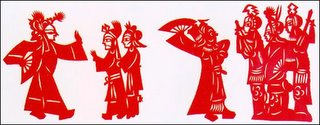 Xian produces a wide variety of paper-cuts. Some of them are meticulously made, exquisite and delicate; some are simple, bold and unsophisticated; and the others have clear-cut lines, and exaggerative patterns. All of them have rich connotations and profound meanings, full of life interest and flavor. "Eight Immortal Cross the Sea and Rat Marries Off His Daughter" were created by folk artists Yang Xixian and Liu Xiufang, respectively, have been highly acclaimed by Chinese and foreign tourists.
Xian produces a wide variety of paper-cuts. Some of them are meticulously made, exquisite and delicate; some are simple, bold and unsophisticated; and the others have clear-cut lines, and exaggerative patterns. All of them have rich connotations and profound meanings, full of life interest and flavor. "Eight Immortal Cross the Sea and Rat Marries Off His Daughter" were created by folk artists Yang Xixian and Liu Xiufang, respectively, have been highly acclaimed by Chinese and foreign tourists.
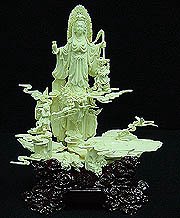 Xian is one of the birthplaces of jade carving in China. Jade carving of Xian can be traced back to the New Stone Age, 5,000 to 6,000 years ago. Local jade carvers have carried forward and developped this traditional art. With meticulously selected Lantian jade, Shenmu agate and high-quality jade from other parts of China and the world, they have created rich and varied jade articles, which fall into five categories, i.e., figures, flowers, birds and animals,vases and ornaments. All of the jade products are beautifully sharped, exquisite, crystal-clear, glittering and bright. In particular, the jade works of Heavenly King,
Xian is one of the birthplaces of jade carving in China. Jade carving of Xian can be traced back to the New Stone Age, 5,000 to 6,000 years ago. Local jade carvers have carried forward and developped this traditional art. With meticulously selected Lantian jade, Shenmu agate and high-quality jade from other parts of China and the world, they have created rich and varied jade articles, which fall into five categories, i.e., figures, flowers, birds and animals,vases and ornaments. All of the jade products are beautifully sharped, exquisite, crystal-clear, glittering and bright. In particular, the jade works of Heavenly King,
Bodhisattava, lions, bracelets, bowls and drinking vessels have been well received by
tourists both at home and abroad.
What to shop in Xian
These are just some of recommended local products of Xian which are very well-known.Qin Embroidery, Xian
 Qin Embroidery was originally a long established art form of Shaanxi Province; it was developed by local master embroiders on the basis of traditional Chinese embroideries. Qin embroidery is very well known for its elegant and neat needlework, finely stitched patterns positioned in proper perspective, a riot of colors and a good effect of tone and depth of the fine work.
Qin Embroidery was originally a long established art form of Shaanxi Province; it was developed by local master embroiders on the basis of traditional Chinese embroideries. Qin embroidery is very well known for its elegant and neat needlework, finely stitched patterns positioned in proper perspective, a riot of colors and a good effect of tone and depth of the fine work.Guangzhong Leather - Silhouette Show, Xian
 Leather sihoulettes are made of cattle hide, sheepskin and donkey hide after they are oppressed, polished, carved and painted. It was originated since the Han Dynasty 206 B.C. - 220 A.D., Guangzhong leather Silhouettes have inherited the traditions of Han stone frescoes and developed the advantages of paintings of the Song Dynasty 960 - 1279. Local artisans display the figures' facial features, status, clothes and personalities through precise and meticulous carving. Guangzhong leather - Silhouette show is characterized by life-like figures, and a strong local, ethic and artistic flavor, hence it has been well received by domestic and foreign tourists. The classical works of Guangzhong leather-Silhouette show includes "Princess Wencheng Enters Tibet and Imperial Concubine Yang".
Leather sihoulettes are made of cattle hide, sheepskin and donkey hide after they are oppressed, polished, carved and painted. It was originated since the Han Dynasty 206 B.C. - 220 A.D., Guangzhong leather Silhouettes have inherited the traditions of Han stone frescoes and developed the advantages of paintings of the Song Dynasty 960 - 1279. Local artisans display the figures' facial features, status, clothes and personalities through precise and meticulous carving. Guangzhong leather - Silhouette show is characterized by life-like figures, and a strong local, ethic and artistic flavor, hence it has been well received by domestic and foreign tourists. The classical works of Guangzhong leather-Silhouette show includes "Princess Wencheng Enters Tibet and Imperial Concubine Yang".Folk Paper-cuts, the traditional art of Xian
 Xian produces a wide variety of paper-cuts. Some of them are meticulously made, exquisite and delicate; some are simple, bold and unsophisticated; and the others have clear-cut lines, and exaggerative patterns. All of them have rich connotations and profound meanings, full of life interest and flavor. "Eight Immortal Cross the Sea and Rat Marries Off His Daughter" were created by folk artists Yang Xixian and Liu Xiufang, respectively, have been highly acclaimed by Chinese and foreign tourists.
Xian produces a wide variety of paper-cuts. Some of them are meticulously made, exquisite and delicate; some are simple, bold and unsophisticated; and the others have clear-cut lines, and exaggerative patterns. All of them have rich connotations and profound meanings, full of life interest and flavor. "Eight Immortal Cross the Sea and Rat Marries Off His Daughter" were created by folk artists Yang Xixian and Liu Xiufang, respectively, have been highly acclaimed by Chinese and foreign tourists.Xian Jade Carving
 Xian is one of the birthplaces of jade carving in China. Jade carving of Xian can be traced back to the New Stone Age, 5,000 to 6,000 years ago. Local jade carvers have carried forward and developped this traditional art. With meticulously selected Lantian jade, Shenmu agate and high-quality jade from other parts of China and the world, they have created rich and varied jade articles, which fall into five categories, i.e., figures, flowers, birds and animals,vases and ornaments. All of the jade products are beautifully sharped, exquisite, crystal-clear, glittering and bright. In particular, the jade works of Heavenly King,
Xian is one of the birthplaces of jade carving in China. Jade carving of Xian can be traced back to the New Stone Age, 5,000 to 6,000 years ago. Local jade carvers have carried forward and developped this traditional art. With meticulously selected Lantian jade, Shenmu agate and high-quality jade from other parts of China and the world, they have created rich and varied jade articles, which fall into five categories, i.e., figures, flowers, birds and animals,vases and ornaments. All of the jade products are beautifully sharped, exquisite, crystal-clear, glittering and bright. In particular, the jade works of Heavenly King,Bodhisattava, lions, bracelets, bowls and drinking vessels have been well received by
tourists both at home and abroad.
Shaanxi Green Tea
Shaanxi Green Tea or Shaanxi Greenery, especially Zi Yang Fu Xi Tea is considered to be the best tea of China. Shaanxi Green Tea is mainly cultivated and produced in the southern part of shaanxi province where are one of the key tea-leaf production areas of China. Shaanxi Green Tea is famous for its lasting aftertaste, clear tea water and fragrant smell. In addition,the tea has various curative effects and very good for health.










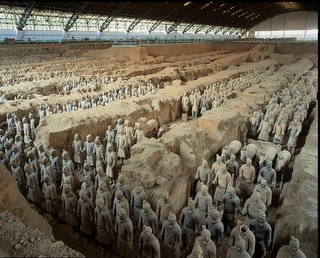
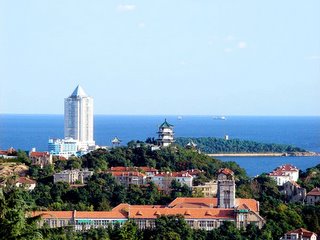
 Nowadays when we are talking about animal in China someone may think about Panda, the cute Panda is the national animal of China but the symbol of Chinese spirit may not avoid Dragon which was believed to be the path into greater enlightenment.
Nowadays when we are talking about animal in China someone may think about Panda, the cute Panda is the national animal of China but the symbol of Chinese spirit may not avoid Dragon which was believed to be the path into greater enlightenment.